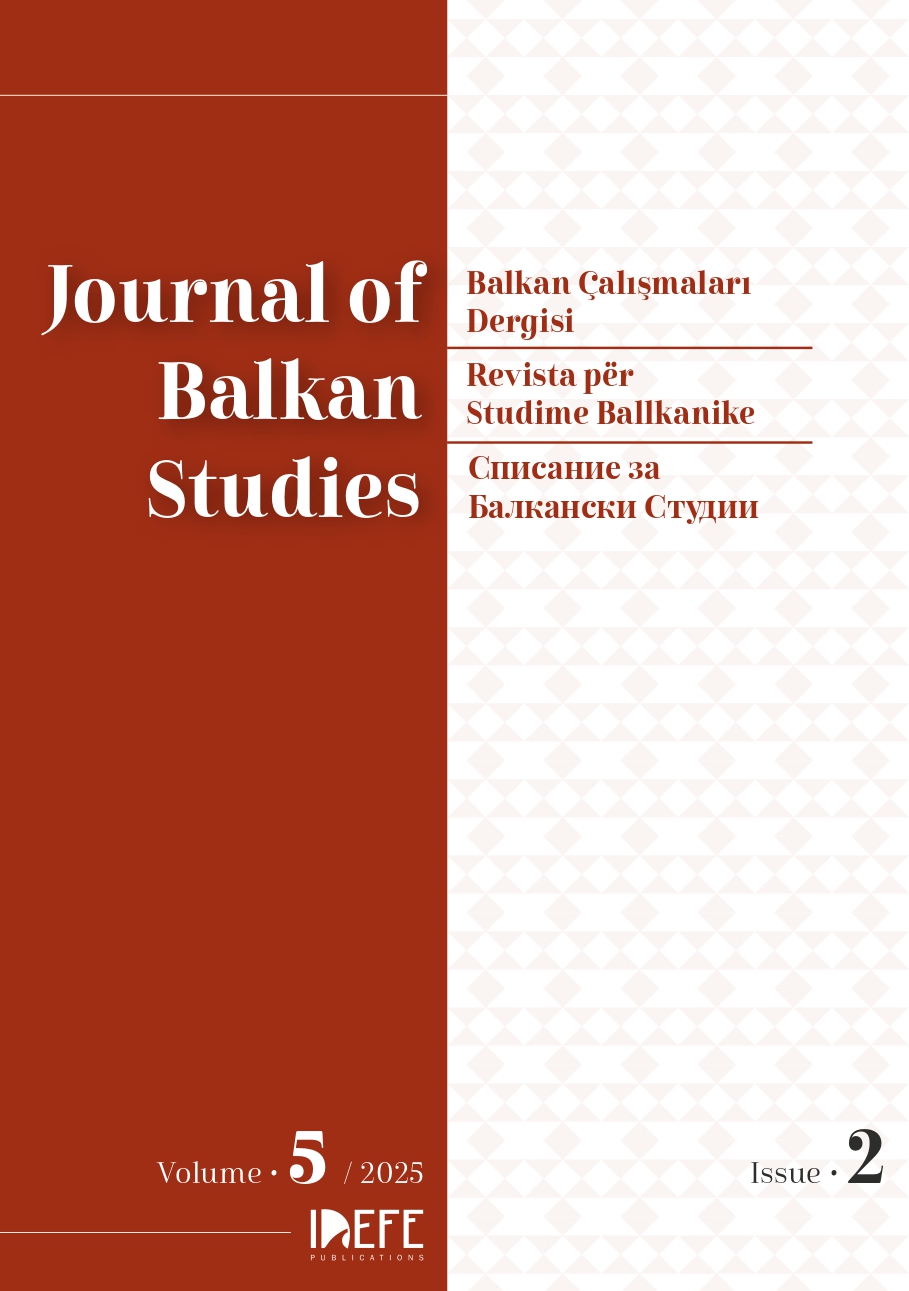Between Empires, Among Believers: A Microhistorical and Borderland Analysis of Benedikt Kuripešić’s 1530 Travel Diary
This article offers a microhistorical and borderland-centered analysis of Benedikt Kuripešić’s 1530-1531 travel diary, composed during a Habsburg diplomatic mission to Ottoman Constantinople. Often cited yet rarely studied in depth, Kuripešić’s text is reinterpreted here as more than a record of geographic movement; it is a rich epistemic artifact that captures early modern inter-imperial friction in the Balkan borderlands. Drawing on the methodologies of Carlo Ginzburg and Anssi Paasi, the article argues that Kuripešić’s diary reveals how borders were experienced not only through political boundaries but through affective registers: faith, fear, memory, and resistance.
Through close readings of selected diary entries, such as encounters with chained Christian children or whispered appeals from peasants, the article illuminates the lived experience of Ottoman-Christian coexistence. It also traces Kuripešić’s rhetorical positioning as interpreter, diplomat, and narrator of martyrdom, highlighting how sacred geography and narrative mapping became acts of Christian counter-sovereignty. The legend of Miloš Obilić, retold with reverence, is analyzed as a key site of myth-making and identity projection. Furthermore, the article explores the Ottoman strategies of governance; taxation, devşirme, and regulated religious tolerance, as an early form of “soft conquest”, prefiguring modern theories of biopolitics.
By combining microhistory and border theory, the study demonstrates that Kuripešić’s “small text” bears large historical implications for understanding Balkan identity, imperial subjectivity, and religious resilience across fluid frontiers.
Agamben, G. (1998). Homo Sacer: Sovereign Power and Bare Life. Stanford: Stanford University Press.
Aksan, V. H. (1999). Locating the Ottomans among Early Modern Empires. Journal of Early Modern History, 3(3), 103-134.
Ballinger, P. (2004). "Authentic Hybrids in the Balkan Borderlands." Current Anthropology, 45(1), 31–60.
Bataković, D. T. (2015). Kosovo and Metohija: History, Memory, Identity. Christian Heritage.
Bayraktaroğlu, B. (2021). Children and slavery in the Ottoman Empire. Access address: https://scholar.google.com/scholar?cluster=14804699241626787546
Bhabha, H. K. (2012). The location of culture. routledge.
Bozluolcay, M. (2023). Coalescence of the Empire: Administration of the Provincial Economy in Ottoman Damascus, 1820–1860 (Doctoral dissertation, Princeton University).
Campbell, M. B. (1999). Wonder & Science: Imagining Worlds in Early Modern Europe. Ithaca: Cornell University Press.
Ćorović, V. (1933). Istorija Jugoslavije. Belgrade: Narodna Knjiga.
Cosgrove, D. (2008). Geography and Vision: Seeing, Imagining and Representing the World. London: I.B. Tauris.
Zemon Davis, N. (2000). The Gift in Sixteenth-Century France. Madison: University of Wisconsin Press.
Zemon Davis, N. (2011). Revealing, Concealing: Ways of Recounting the Self in Early Modern Times.
De Busbecq, O. G., Forster, C. T., & Daniell, F. H. B. (1881). The Life and Letters of Ogier Ghiselin de Busbecq (Vol. 1). CK Paul.
de Certeau, M. (1984). The Practice of Everyday Life. Transl. Steven Rendall. Berkeley: University of California Press.
Dobreva, B. (2011). Subjectivity Regained?.
Foucault, M. (2004). Naissance de la biopolitique: Cours au Collège de France (1978–1979). Paris: Gallimard/Seuil.
Ginzburg, C. (1993). "Microhistory: Two or Three Things That I Know about It." Critical Inquiry, 20(1), 10–35.
Ginzburg, C. (2012). The Cheese and the Worms: The Cosmos of a Sixteenth-Century Miller. (Çev. Anna Tedeschi, John Tedeschi). Baltimore: Johns Hopkins University Press.
Grmusa, L. G., & Oklopcic, B. (2022). Hybrid Identities on the Balkan Border. In Culture and Identity in Modern and Postmodern American Literature. Springer.
Hayden, R. M. (2007). Moral vision and impaired insight: The imagining of other peoples’ communities in Bosnia. Current Anthropology, 48(1), 105-131.
Konrad, H. W., & Scott, J. C. (2011). Borderlands and Border Crossings: Reconceptualizing Boundaries in the Balkans. Vienna: LIT Verlag.
Kuripešić, B. (1531). Путевой дневник посольства королевского величества в Константинополь к турецкому императору Сулейману в год 1530–1531. Transl. M. Hartanovich. Sarajevo: Svjetlost, 1950.
Kuripešić, B. (1950). Putopis kroz Bosnu, Srbiju, Bugarsku i Rumeliju 1530. Sarajevo: Svjetlost.
Laine, J. P., & Casaglia, A. (2017). Challenging borders: A critical perspective on the relationship between state, territory, citizenship and identity. Europa Regional, 25(1–2), 3–11.
Laven, D., & Baycroft, T. (2008). "Border Regions and Identity." European Review of History, 15(2), 127–142.
Ljuckanov, Y. (2015). "Bulgarian Cultural Identity as a Borderline One." Interlitteraria, 20(2), 198–213.
Lovrenović, D., & Ressner, D. (2009). Stećci: bosansko i humsko mramorje srednjeg vijeka. Rabic.
Malcolm, N. (1994). Bosnia: A Short History. New York: NYU Press.
Nestorović, Č. (2023). Critical Geopolitics. In Geopolitics and Business: Relevance and Resonance. Springer. Access address: https://link.springer.com/chapter/10.1007/978-3-031-45325-0_3
Neumann, I. B. (1999). Uses of the other:" the East" in European identity formation (Vol. 9). U of Minnesota Press.
Norton, C. (2007). "Nationalism and the Re-Invention of Identities in the Ottoman–Habsburg Borderlands." Ethnologia Balkanica, 11, 141–155.
Paasi, A. (2000). Political borders. In Kobayashi, Audrey (editor). International Encyclopedia of Human Geography. Oxford: Elsevier, available at: https://www.academia.edu/39312486/Paasi_Anssi_2020_Political_borders_In_Kobayashi_Audrey_editor_International_Encyclopedia_of_Human_Geography_Oxford_Elsevier
Paasi, A. (1999). "Boundaries as Social Processes: Territoriality in the World of Flows." Geopolitics, 3(1), 69–88.
Rubiés, J. P. (2002). Travel and ethnology in the Renaissance: South India through European eyes, 1250-1625. Cambridge University Press.
Scott, J. C. (2009). The Art of Not Being Governed: An Anarchist History of Upland Southeast Asia. New Haven: Yale University Press.
Stahuljak, Z. (2010). Minor Empires. In Translation and Violent Conflict.
Stanić, D. (2017). Ambivalentna lojalnost na Hrvatskoj krajini u 16. stoljeću.
Thomas, K. (2022). Tea, Fiction, and the Imperial Sensorium. Victoriographies, 12(2), 168-188.
Todorova, M. (1997). Imagining the Balkans. Oxford: Oxford University Press.
Yılmaz, G. (2021). Body Politics and the Devşirmes in the Early Modern Ottoman Empire: The Conscripted Children of Herzegovina. Children and Childhood in the Ottoman Empire: From the 15th to the 20th Century, Edinburgh University Press, 239-263. Access address: https://www.degruyter.com/document/doi/10.1515/9781474455411-015/pdf?licenseType=restricted

Copyright (c) 2025 Srđan Jovanović (Author)
This work is licensed under a Creative Commons Attribution-NonCommercial 4.0 International License.
Downloads
Article Information
- Article Type Articles
- Submitted June 27, 2025
- Accepted July 19, 2025
- Published July 30, 2025
- Issue Volume 5 - Issue 2 (July 2025)
- Section Articles






